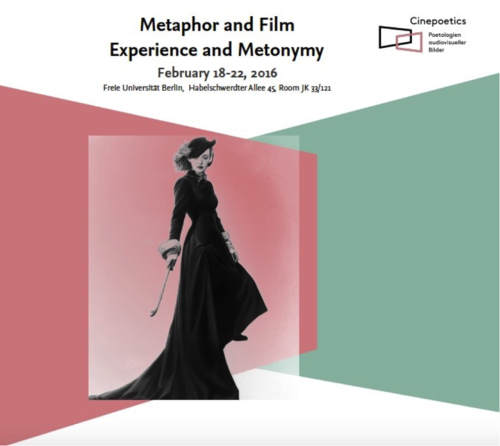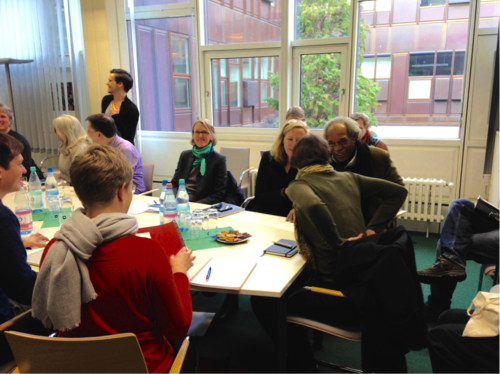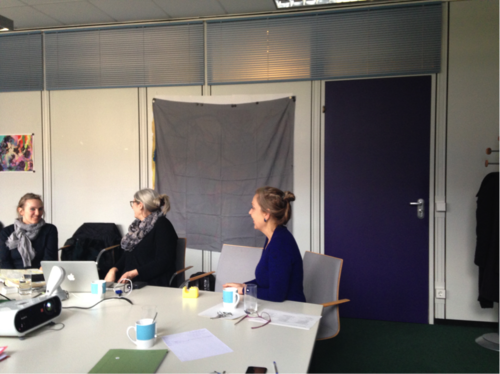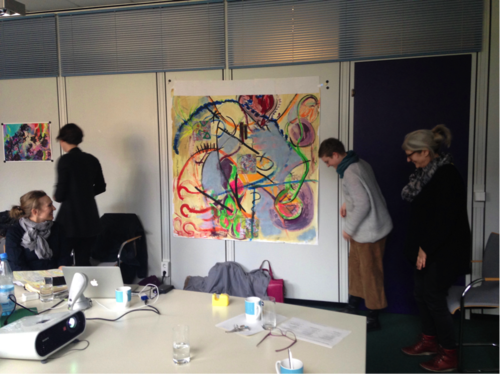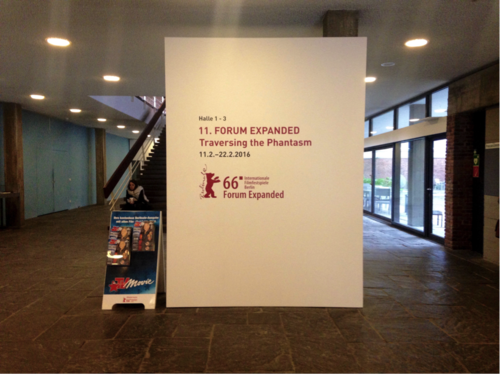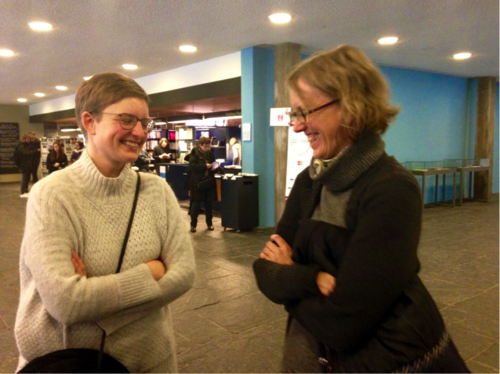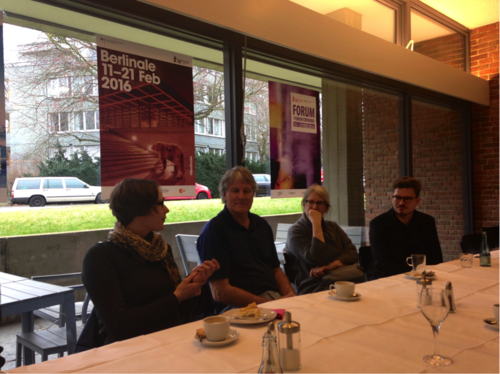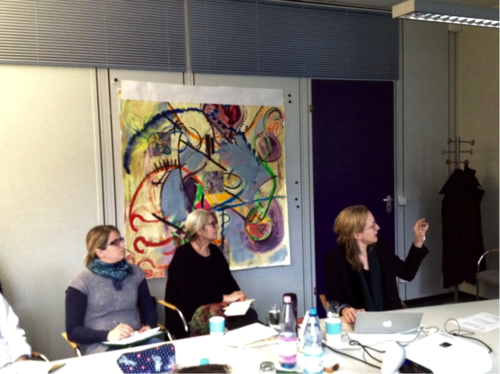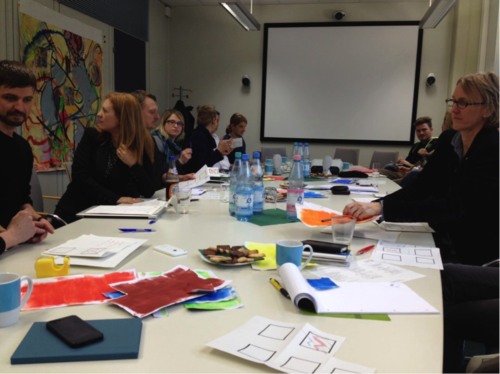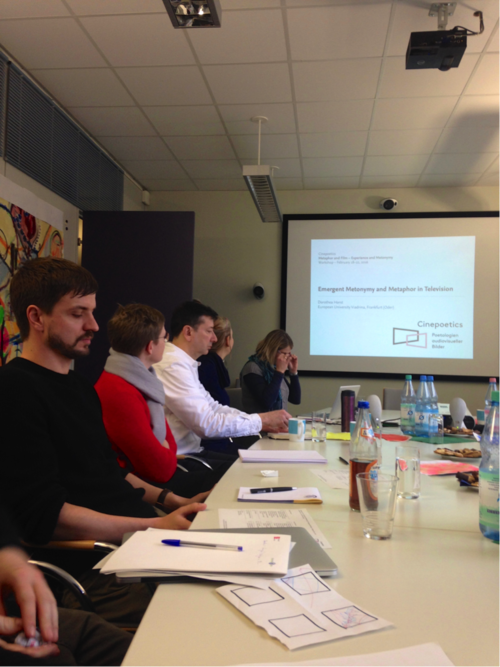Metaphor and Film: Experience and Metonymy
18. – 22.02.2016 | Workshop by the Cinepoetics group with Cornelia Müller (Frankfurt/Oder), Hermann Kappelhoff (Berlin), Lynne Cameron (London), Alan Cienki (Amsterdam), Raymond W. Gibbs, Jr. (Santa Cruz), Irene Mittelberg (Aachen).
The Cinepoetics workshop on "Metaphor and Film: Experience and Metonymy," combined film-analytical, psychological, linguistic, and artistic approaches to expressive movement and metonymy, featuring presentations by Cornelia Müller (Professor for Language Use and Multimodal Communication, European University Viadrina), Hermann Kappelhoff (Professor of Film Studies, FU Berlin), Lynne Cameron (Artist and Professor for Applied Linguistics, Open University, London), Raymond W. Gibbs Jr. (Professor of Psychology, University of California, Santa Cruz), Irene Mittelberg (Assistant Professor of Linguistics and Cognitive Semiotics, RWTH Aachen), and Dorothea Horst (Research Associate at the Chair for Language Use and Multimodal Communication, European University Viadrina).
Our Experiences of Film
After a short introduction, the participants attended a preliminary screening of William Wyler’s Jezebel (USA 1938) on Thursday. In their Friday paper, “Expressive Movement: Cinematic Experience and the Experiential Grounding of Metaphors,” Cornelia Müller and Hermann Kappelhoff went into detail about expressive movement as a film-analytical concept, which they defined as “mood extended over time.” Müller first explained how the term had been used within different historical and theoretical frameworks (Art Theory, Aesthetic Philosophy, Psychology, Anthropology, Linguistics, Phenomenology, Film Theory, and Contemporary Media Theory). While traditional concepts treat expression as proof of the inner orientations of a human subject, modern concepts conceive of expressive behaviour as interplay of affective transferals of intensities. Taking this exchange process into account, it can be said that film itself performs acts of expressivity (“moving audiovision”) that become manifest only in a spectator experiencing the film over time.
With regard to linguist Karl Bühler’s idea that the expressive function of gestures lies in their movement qualities, cinematic expressive movement can be defined as an audio-visual movement gestalt comparable to a gestural hand movement. Based on this theoretical outline, Müller and Kappelhoff analysed the first scene of Jezebel in terms of dynamic expressive qualities, translating the sequence’s distinct movement pattern into a metaphoric process: the audio-visual movement gestalt unfolding over the course of the scene articulates a certain image of society as depicted in the film.
Raymond W. Gibbs Jr., in his presentation “Our Experience of Film”, explored the idea of cinematic experience in psychological terms: According to him, film experiences are specific, contextualized, cognitive, affective, and involve our entire bodies in real and imaginative action. Gibbs thus suggested to apply the psychological concept of “embodied simulations.” Such experiences emerge from a constellation of interacting constraints that are both specific to film and, more generally, life itself. Furthermore, our experiences of metaphorically orchestrated movements are not discrete but unfold as cascades of thoughts and feelings over time, which led Gibbs to compare them to a mountain stream.
Artworks / Art Works
Vivid associations were also made when Lynne Cameron revealed the collaborative artwork she and members of Cinepoetics had created in January. Together with the group she retraced the painting’s evolutionary stages, the artistic decisions made, and the intuitive shapes and directions the artwork developed into. Being born simply out of drawn lines and textual fragments, the complexity and metonymic quality of the finished painting testifies to the “emergent poetic,” to the experience of art making and self-exploration through art.
Field trip: “Traversing the Phantasm”
Excursion to the Berlin International Film Festival.
Christina Schmitt and Kathrin Fahlenbrach enjoy a pleasant conversation.
Regina Brückner, Ray Gibbs, Lynne Cameron, and Björn Hochschild.
Over the weekend, the participants were given enough time to catch a glimpse of the Berlin International Film Festival. As it was the workshop’s joint activity, a large group of professors, post-docs and PhD-candidates roamed through the halls of the Academy of the Arts where the exhibition “Traversing the Phantasm” took place. It was part of the Berlinale section “Forum Expanded” and presented 13 video installations from all over the world.
The topic was particularly interesting for the participants since it addressed the question: “What traces are left behind by a work of art in the recipient?” Not surprisingly, a fruitful discussion on the exhibition emerged afterwards.
Metonymy between Language, Art, and Body
Irene Mittelberg presents her thoughts on "Metonymic Moments", also pictured: Dorothea Horst and Lynne Cameron.
In her talk on “Metonymic Moments in the Flow of Semiotic Experience”, Irene Mittelberg explored the special qualities of metonymy in language and media. Metonymy uses the fundamental semiotic principle of partial representation. Thus, it is able to present a certain perspective that is reflected in the rhetorical tropes of pars pro toto, synecdoche and metonymy itself.
As bodily perception is also partial, Mittelberg pointed out, it is possible to find “metonymic moments” in time (e.g. in talk or film). She concluded that meaning-making is a “highly complex interaction of embodied interpretations of metonymic acts.” Drawing on the example of Sir Norman Foster talking about his design of the “Sperone Westwater Gallery” in New York, Mittelberg explained the notion of the “embodied image icon”. This concept describes a speaker who uses gestures to imitate the situation he describes verbally. In this case an elevator shaft rising before the imaginative viewer.
Mittelberg gave another illustration of the complex metonymic relations between artwork and recipient, taking up and further developing Roman Jakobson’s remarks about Cubism being an inherently metonymic form of art. While the author and literary critic David Lodge sees “slices of life” in the paintings of Braque, Picasso and others, Mittelberg specified this notion: In looking at Cubist paintings, one can observe metonymic processes like “fragmentation, essence, contour and perspective.” (see also Mittelberg 2006, 2011) Furthermore, she said in a closing statement, we are able to “work out mediality effects of how a given medium influences the workings and preferences for certain metonymic modes.”
The Collaborative Artwork “Workshop 2”
While the first collaborative painting for the workshop “Metaphor and Film: Dynamics and Multimodality” started out with contours and gestures imitating them, Lynne Cameron chose a different approach to the next artwork. She asked the participants to close their eyes and think of a color for the workshop, suggesting afterwards that people with similar colors in their mind get together and work on first drafts of the painting. These were made out of scribbles on paper in the respective color each participant had in mind. For further work on the painting in the Center’s weekly “Studio Interlude”, Cameron asked the attendees for a list of words relating to the chosen color. What’s the name of the color? Where can it be found in the natural world, or in an urban environment? What metaphors are evoked by this certain color? Both colors and words, will find their way into the collaborative artwork which will be presented at the next workshop.
Angela Merkel’s Multimodal Metaphors
Dorothea Horst’s presentation, “Emergent Metonymy and Metaphor in Television”, featured a detailed analysis of a 2009 campaign commercial by the German party “Christlich Demokratische Union” (CDU). Here, Chancellor Angela Merkel is shown in different environments while archival footage blends into the main image. A voice-over by Merkel herself specifies the party’s goals for the next legislative period as well as her main achievements.
As Horst pointed out, the clip consists of two expressive movement units. While the first half of the broadcast centers on historical events and cultural memory, underlined by widely known footage of the 2006 soccer championship, or the fall of the Berlin Wall, the second half centers on Merkel as a person. According to Horst, what is staged here is a “multimodal foregrounding of power, dominance, and centrality”. On the one hand, this is achieved through a circling camera movement as opposed to the static images in the first half; on the other hand, it is also attained by means of the more solemn music towards the end, which corresponds to the rhythm of the montage.
To put these findings as well as the following discussion into perspective, Dorothea Horst’s project will move on to an in-depth-analysis of Polish campaign commercials. Applying the method of analyzing expressive movement images will thus offer insights into the cultural differences and concordances of German and Polish audiovisual culture.


